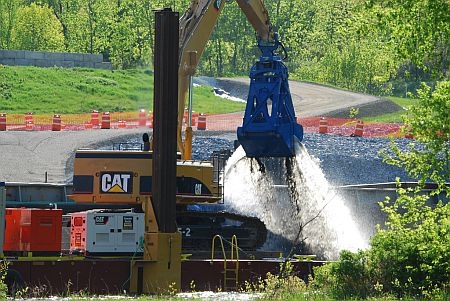
(Host) Four-hundred years after Henry Hudson sailed up the river that bears his name, one of the biggest toxic waste cleanups has just begun in an attempt to restore the Hudson to health.
Environmentalists fought more than 30 years for the cleanup, but not everyone’s on board. As part of a collaboration with Northeast public radio stations, David Chanatry reports:
(Chanatry) On a sunny spring day, government officials, environmental activists and local residents stood along the banks of the Hudson celebrating a moment many thought would never come. George Pavlou of the U.S. Environmental Protection Agency told the crowd the day marked the next chapter of the Hudson’s history.
(Pavlou) "Today the healing of the Hudson River begins."
(Chanatry) Manna Jo Greene is standing on the river’s edge, watching the dredges that hoisted the first loads of toxic muck from the bottom. Greene is with Clearwater, a group that pushed for decades for the cleanup.
(Greene) "We are jubilant! It was the little engine that could, it was David versus Goliath."
Visit The Northeast Environmental Reporting Hub Main Page
(Chanatry) Goliath in this case is General Electric. Over the course of 30 years GE -legally-discharged more than a million pounds of PCB’s, or polychlorinated biphenyls, into the river. But in the 1970s the government classified the chemicals as probable carcinogens and banned them. By 1984 it declared the river a 200 mile long Superfund site.
(Behan) "We have made a very public commitment to do this project."
(Chanatry) That’s GE spokesman Mark Behan. General Electric is running the project, and paying the bills, estimated to cost nearly 800 million dollars.
(Behan) "We have assembled a world class team of environmental engineers, dredging experts and others to ensure the project is done as effectively and safely as possible."
(Chanatry) This cleanup is complex. GE will use a dozen dredges, 18 tugboats and 35 barges to scour the PCB’s from hotspots in a five mile stretch of the upper river. It’ll separate the water from the contaminated mud at a facility it built nearby, seal it up in railroad cars and ship two trains a week to a toxic waste site in Texas.
In some ways they’ve got this down, but the EPA’s Walter Mugdan says it’s not easy to work underwater.
(Mugdan) "It’s difficult to deal with contaminated sediment in any aquatic environment because dredging is inherently a potentially a messy process. so you have to make sure the cure is not worse than the disease."
(Chanatry) In other words dredging could stir up the PCB-laden sediment that was once buried.
(Havens) "It really makes me sad."
(Chanatry) Tim Havens runs a tractor supply business in Hudson Falls. He’s led the fight against dredging and has been one of the EPA’s most vocal opponents. He’s watching the start of the dredging from an island in the river where he can get clear view.
(Havens) "Now due to the fact they’ve stopped industrial dumping the river is coming back. Mother Nature takes care of itself. What we’re doing here is we’re going to set this whole thing back a lot of years."
(Chanatry) Havens thinks the project will just re-suspend the chemicals in the water. But the EPA’s Mugdan says his agency will monitor for exactly that. He says the cleanup will pay dividends outside the Hudson Valley as well.
(Mugdan) "The experience we gain on a project like this one is going to be invaluable as we look to the many, many other places around our country where aquatic waterways and particularly urban waterways are so heavily contaminated."
(Chanatry) Those PCB cleanup sites include the Housatonic River which runs through Massachusetts and Connecticut and New Bedford harbor.
General Electric has dozens of active sites on the Superfund list. Vermont Law professor Pat Parenteau points out many polluters have gone bankrupt, but GE is still thriving.
(Parenteau) "Unfortunately for GE, its very success has meant that it remains on the hook for a very substantial part of this industrial pollution legacy."
(Chanatry) Parenteau says GE is looking for some financial relief by challenging the Superfund law in federal court.
As for the Hudson cleanup, both EPA and GE consider this year’s dredging to be a test, and company has not yet agreed to clean the rest of the river. The EPA says it will finish the job if it has to, and send GE the bill.
For VPR News, I’m David Chanatry….
(Host outro) Northeast environmental coverage is part of NPR’s Local News Initiative. It is supported, in part, by a grant from United Technologies.